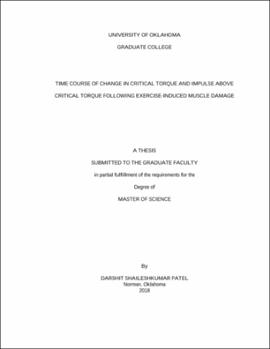| dc.contributor.advisor | Black, Christopher | |
| dc.contributor.author | Patel, Darshit | |
| dc.date.accessioned | 2018-05-09T16:21:48Z | |
| dc.date.available | 2018-05-09T16:21:48Z | |
| dc.date.issued | 2018-05-11 | |
| dc.identifier.uri | https://hdl.handle.net/11244/299820 | |
| dc.description.abstract | Exercise-induced muscle damage (EIMD) is a result of high-force eccentric contractions and can lead to significant alterations in the structure and function of skeletal muscles. Critical torque (CT) and the impulse above critical torque (IACT) have both been reported to decrease following EIMD. PURPOSE: The purposes of this study were to 1) observe the time course of change in CT and IACT up to 7-days following EIMD, and 2) to assess the extent to which central and peripheral fatigue contribute to changes in CT and IACT following EIMD. METHODS: Participants (males = 6, females = 4) completed 2 familiarizations and 5 experimental visits. Fatigue patterns were assessed, and CT and IACT were derived at the 1st experimental visit. The 2nd experimental visit included an EIMD protocol consisting of 100 back squats. The 3rd, 4th, and 5th experimental visits were identical to the 1st. CT and IACT were acquired through voluntary and stimulated conditions. RESULTS: The participant’s ratings of muscle soreness were significantly elevated up to 4-days following EIMD (p<0.05). Dominant leg MVIC was reduced up to 2-days (p<0.05) while non-dominant leg MVIC was reduced up to 4-days (p<0.05) following EIMD. Mean CT was decreased up to 4-days following EIMD in the voluntary condition (p<0.05) while decreases lasted up to 2-days in the stimulated condition (p<0.05). IACT was not significantly different following EIMD in either conditions (p>0.05). Voluntary activation was not significantly different following EIMD (p>0.05) and these results are the same for twitch torque (p>0.05). EMG RMS and twitch torque both showed a significant reduction during the voluntary CT test (p<0.05). There were no changes in low-frequency fatigue after the voluntary and stimulated conditions (p>0.05) or following EIMD (p>0.05). CONCLUSIONS: Even though CT was lower following EIMD, IACT was not. Additionally, our results show no contribution of central or peripheral fatigue on torque production following EIMD. These findings suggest the loss in torque production following EIMD to be a factor of EIMD’s effect on muscular function and not the central and peripheral mechanisms of fatigue. | en_US |
| dc.language | en_US | en_US |
| dc.subject | Critical Torque | en_US |
| dc.subject | Muscle Damage | en_US |
| dc.subject | Fatigue | en_US |
| dc.subject | Electrical Muscle Stimulation | en_US |
| dc.title | TIME COURSE OF CHANGE IN CRITICAL TORQUE AND IMPULSE ABOVE CRITICAL TORQUE FOLLOWING EXERCISE-INDUCED MUSCLE DAMAGE | en_US |
| dc.contributor.committeeMember | Bemben, Michael | |
| dc.contributor.committeeMember | Campbell, Jason | |
| dc.date.manuscript | 2018-05-09 | |
| dc.thesis.degree | Master of Science | en_US |
| ou.group | College of Arts and Sciences::Department of Health and Exercise Science | en_US |
| shareok.orcid | 0000-0003-4708-5497 | en_US |
| shareok.nativefileaccess | restricted | en_US |
